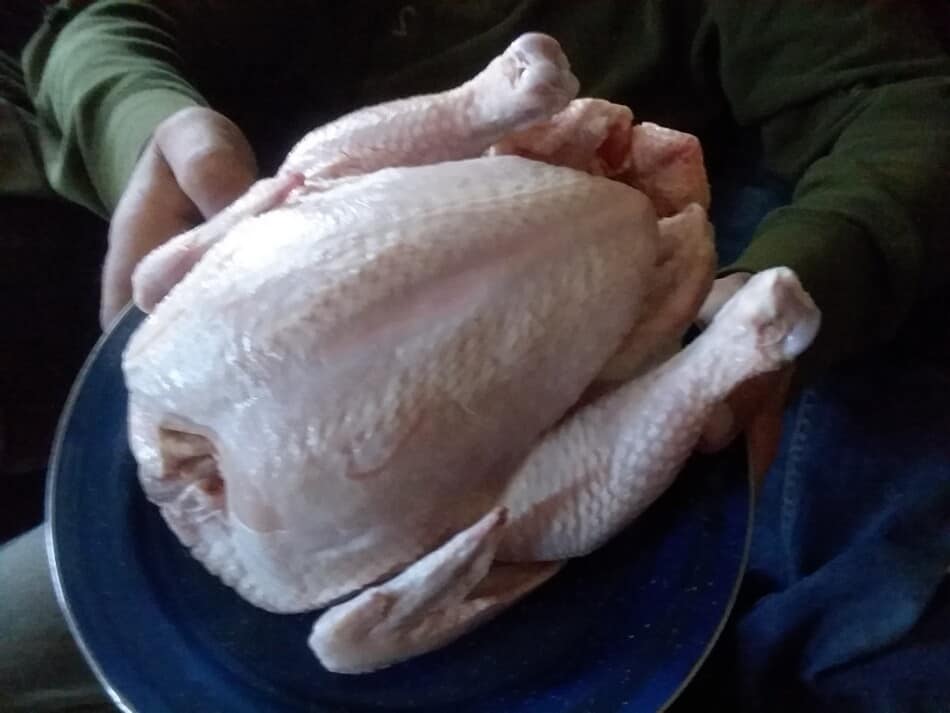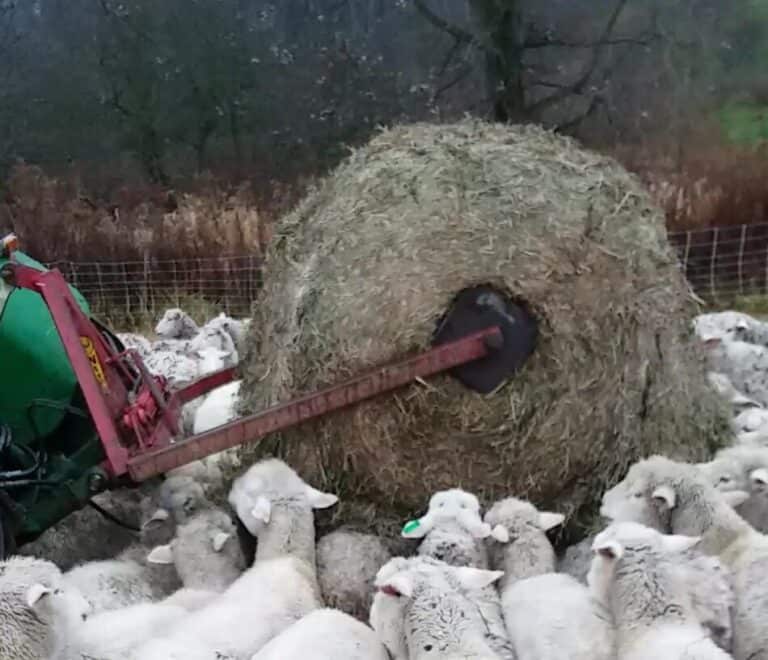Your Family’s Meat For A Year: What To Raise?
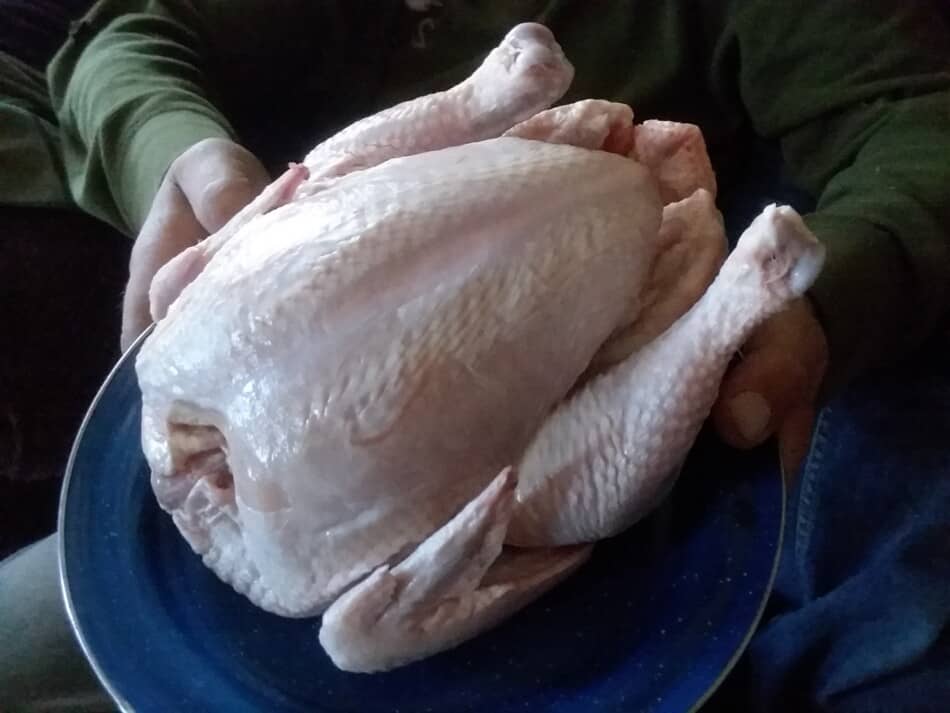
Raising all of your own meat for the year, that’s a lofty goal, especially for a beginner!
How much meat will you need to plan on raising and what combination of animals should you plan to raise?
A family of four will need 892 pounds of meat for a year, on average, consisting of 232 pounds of beef, 209 pounds of pork, 385 pounds of chicken and 64 pounds of turkey.
| Meat source | Pounds eaten (per year, family of 4) | Meat animals needed |
| Beef | 232.4 | half a steer |
| Pork | 209.6 | two pigs |
| Broilers | 380.4 | 109 (3.5 pound chickens) 76 (5 pound chickens) |
| Other chicken | 5.6 | 2 stewing hens |
| Turkey | 64 | 3 (22 pound turkeys) 4 (16 pound turkeys) |
I did a bit of rounding on the pork and beef, to give a sensible total.
To be specific, the 232.4 pounds of beef would be a bit more than a half of a steer and the two pigs needed for pork is actually closer to 1.5 pigs.
The chart above will give you some idea of what you are shooting for, if you are looking to use average meat consumption numbers (This is a neat table on the National Chicken Council site, with data back to 1965!)
As mentioned, these numbers are averages. They will give you a ballpark figure, but you’ll need to get more specific to find the right mix for your family.

Figure up meat needed for the week
You’ll need to have some idea of how often you cook and how much meat you cook per meal. Use numbers that reflect your current eating habits.
If you don’t pay too much attention to planning your meals, start by keeping track of what you normally do for a few weeks, then figure this out.
Count your meals not eaten/cooked at home
Be sure to account for all of the meals you are eating away from home.
Remember, there is no right or wrong here, just figure out what your typical eating week looks like.
If you don’t like the numbers you see, adjust the plan or make two plans.
One plan showing current meat consumption and the second plan showing your family’s ideal meat consumption.
Use leftovers for additional meals
Remember to count leftovers from something like a large roast or a whole chicken.
Cooking once and getting multiple meals is easiest to see with a broiler: the first two days you’ll have plenty of roasted chicken and on the third day make chicken noodle soup.
That’s three days worth of meals from one broiler!
Raise meat you like to eat!
Now that you have an idea of the amount of meat you need for your family, we can start considering which animals to raise.
For this example, we’ll stick with the generic 892 pounds (.6 pounds per person per day) from the chart above and figure out possible combinations of animals that you can raise to “meat” your needs.
Meat animal combos for a family of 4
| Animal | Number to raise | Meat each | Total Meat |
| Broilers | 100 to 7.5 pounds | 5 pounds | 500 |
| Pigs | 2 pigs to 300 pounds | 165 pounds | 330 |
| Lamb | 2 lambs to 100 pounds | 32.5 pounds | 65 |
| Layers | 5 stewing hens | 2.5 pounds | 12.5 |
| 907.5 pounds | |||
| ***** | ***** | ***** | ***** |
| Steer | 1 steer to 1,000 pounds | 430 pounds | 430 |
| Pigs | 2 pigs to 300 pounds | 165 pounds | 330 |
| Broilers | 25 to 7.5 pounds | 5 pounds | 125 |
| 885 pounds | |||
| ***** | ***** | ***** | ***** |
| Rabbits | 100 to 5 pounds | 3.5 pounds | 350 |
| Broilers | 100 to 7.5 pounds | 5 pounds | 500 |
| Ducks | 10 to 7.5-8 pounds | 4 pounds | 40 |
| 890 pounds | |||
| ***** | ***** | ***** | ***** |
| Rabbits | 100 to 5 pounds | 3.5 pounds | 350 |
| Broilers | 50 to 7.5 pounds | 5 pounds | 250 |
| Goats | 4 to 100 pounds | 32.5 pounds | 130 |
| Turkeys | 10 to 25 pounds | 17.5 pounds | 175 |
| 905 pounds |
You can put together your meat animal selection any way that suits you. These are some combinations I came up with to get you thinking.
I tried to list a variety of animals, including some backyard friendly options to give you an idea of how you could put all this together.
The options and combinations are nearly limitless. Think about what makes the most sense for you to start with and get working on filling that freezer!
Choose the types of meat you will be eating
Here is a quick summary of each of your main meat animal options, including how easy it is to raise and the pros and cons of each animal.
You can combine different types of meat animals (like the chart above) to reach the total of meat you need for the year or raise all one type of meat. The choice is yours!


Broilers are ideal for beginners
- Beginner appropriate
- Backyard friendly
- Fast growth, done in 6-8 weeks
Ease: Easy to raise
Pros: Simple to order, backyard appropriate, family friendly, feed and supplies are readily available, finished growing in 6-8 weeks, home butchering is common
Cons: Finding a processor, waiting for a later hatch due to heavy order volume (spring), must be processed on schedule, not heat tolerant, predators, must reorder chicks for each batch, specific feed requirements
Pounds of meat: 3.5 pounds of meat from a 5 pound live bird and 5 pounds of meat from a 7.5 pound live bird
Broilers are a fast and easy beginner project and a great starting point for anyone new to raising animals.
You’ll need a brooder area and to be vigilant on predator protection. Broilers will love your lawn or to scratch through unused sections of your garden.
Here’s an article I wrote on the Red Rangers vs Cornish Cross Broilers, check it out before you order your birds.
Before you order your broiler chicks:
- Be sure to have a butchering appointment set up, the processor’s schedule will fill up fast!
- If you are going to butcher them yourself, have all of your equipment at your house. You don’t want to be on backorder when your birds are ready!
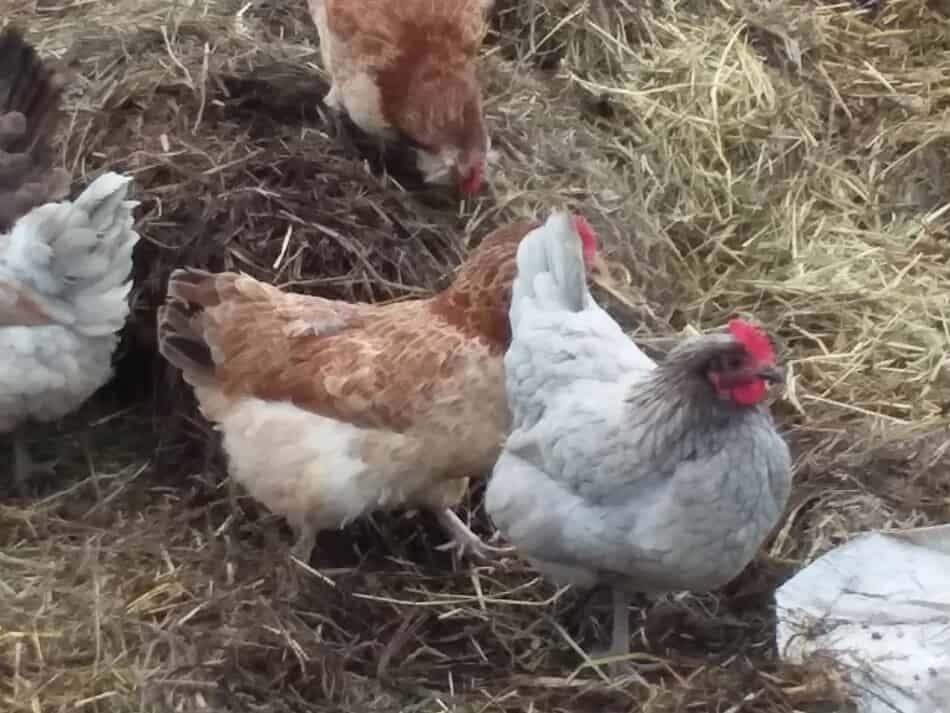
Keep laying hens for eggs then broth
- Already have them for egg supply
- Wonderful for broth
Ease: Fairly easy
Pros: Simple to order, backyard appropriate, most breeds are family friendly, feed and supplies readily available, can be kept for multiple years, home butchering is common
Cons: Laying starts at 5-6 months, can be escape artists, some breeds tend to peck, year round care
Pounds of meat: 2.5 pounds per stewing hen (brown egg layers), less for light breeds (white egg layers)
While you may not have first thought of layers as meat birds, when they are finished laying, in to the freezer they go. If you’ve never had broth (a chef would call it stock) made from stewing hens, you are in for a treat, it’s great stuff!
Laying hens are fairly easy to manage, but do need care year round and will be more active birds than a broiler, especially if you get a smaller breed chicken.
The wonderful opportunity with laying hens is that, if you have a rooster, you can keep raising your own birds and never have to buy chickens again.
Or you can hatch laying breed chicks and sell them to buy broilers or anything else, chicken or otherwise.
The only caution here is that if you get a hybrid layer, like a golden comet, you can not hatch purebred chicks (since she is a cross). This only matters if it matters to you.
If you want to raise purebred layers with an eye toward hatching chicks for sale or replacements, get a traditional laying breed like Barred Rock or Wyandotte.
If you are looking for a calm, friendly layer, read my article 20 Calm Chicken Breeds.
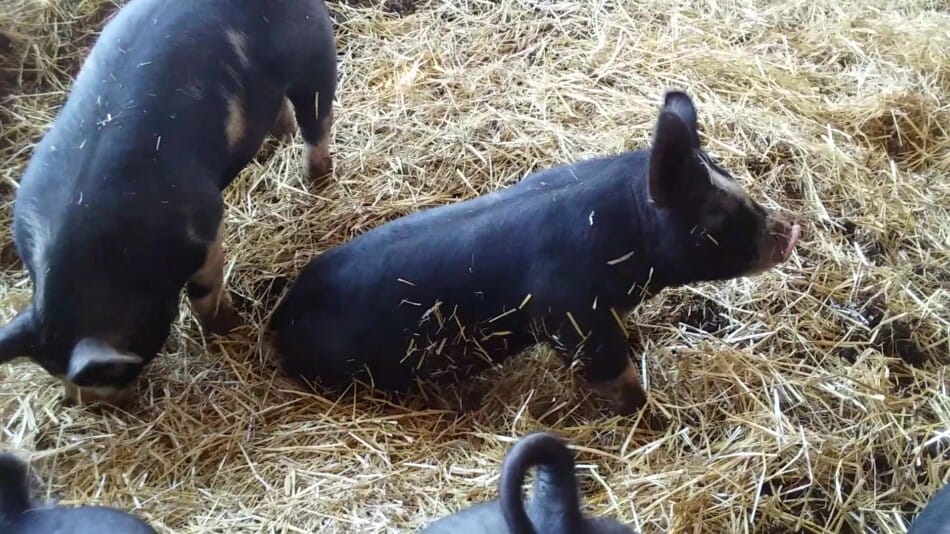
Pigs are economical meat makers
- Lots of meat per pig
- Adaptable
- Backyard friendly
Ease: Moderate
Pros: Lots of meat per finished pig, small acreage friendly, easy to fence with electric, feed and supplies easy to find, great meat poundage return for money spent
Cons: More total money needed, can be hard to find feeder pigs, need 700-800 pounds of feed per pig, need some equipment, need a sturdy pen, will need hauling, home butchering is not common
Pounds of meat: A 260 pound finished pig will provide 144 pounds of freezer ready meat. A 300 pound pig will provide 165 pounds of meat.
Pigs themselves are easy to raise and provide quite a bit of meat per animal raised. Raising your own pork is a great place to start “upping your meat game” when you want to fill that freezer!
I love pigs and enjoy having them around, until they try to get out! That is why they are listed as “moderate” and not easy.
Pigs are strong and capable and will work on getting out of the pen. The easiest way to fix this is with electric fence, it works great for pigs raised outside.
While pigs can be butchered at home, unless you know what you are doing, it is not a great first time project. Make a processing appointment.
I do want to mention, raising pigs will have a decent amount of cash tied up in the pigs and feed, before you get any meat to your freezer.
Read my article Is Raising Pigs For Meat Worth It? for more information, including budgets.
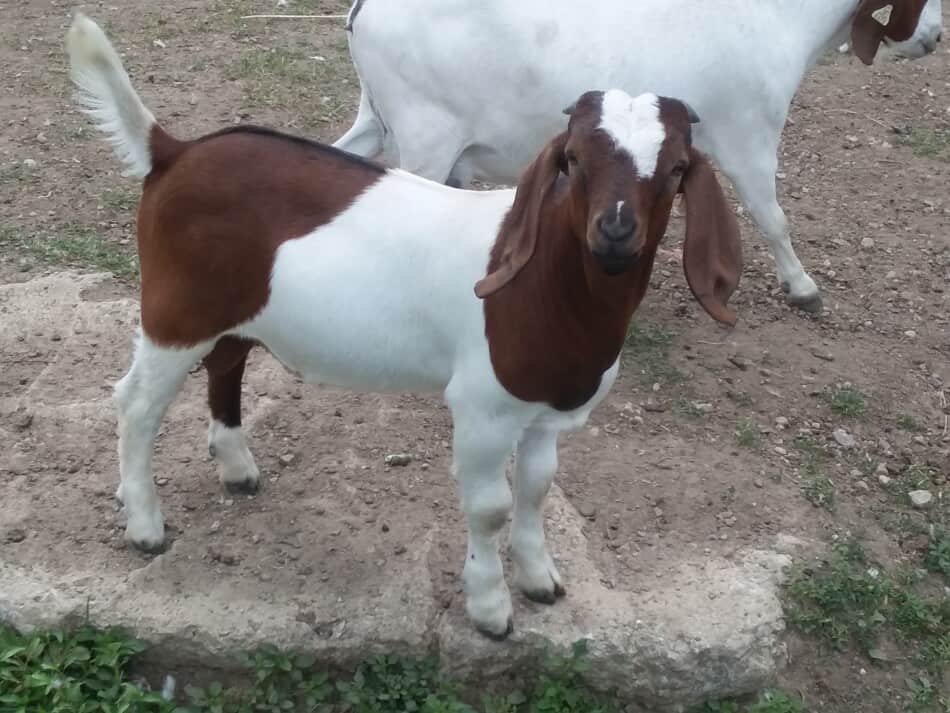
Goats are small acreage friendly
- Backyard friendly
- Family friendly
Ease: Moderately easy
Pros: Goats are great for dry climates, eating back shrubby overgrowth, grow to market size in a few months and are generally personable.
Cons: Goats are escape artists, do not graze (meaning they eat browse not grass), hate cold and/or rain and getting meat genetics.
Pounds of meat: From a 70 pound market goat you will get 22.75 pounds of meat.
Goats are fun animals to have around. We have a few and I get a kick out of them, however, they are characters. They are amazingly agile and creative when it comes to getting out of a pen!
Since goat are browsers, like deer, they will need more to eat than your lawn. If your goats are a meat goat, like Boer or Savanna, they will need some grain, as well.
Meat Goat Profitability is an article I wrote for anyone wanting to dig deeper into the numbers of goat raising.
Regarding pounds of meat, most people that raise goats are selling them at 60-70 pounds, resulting in 22.75 pounds of meat.
If you want to raise your goats to a higher weight, realize that not all genetics will grow well to a larger market kid and it will take quite a bit longer.
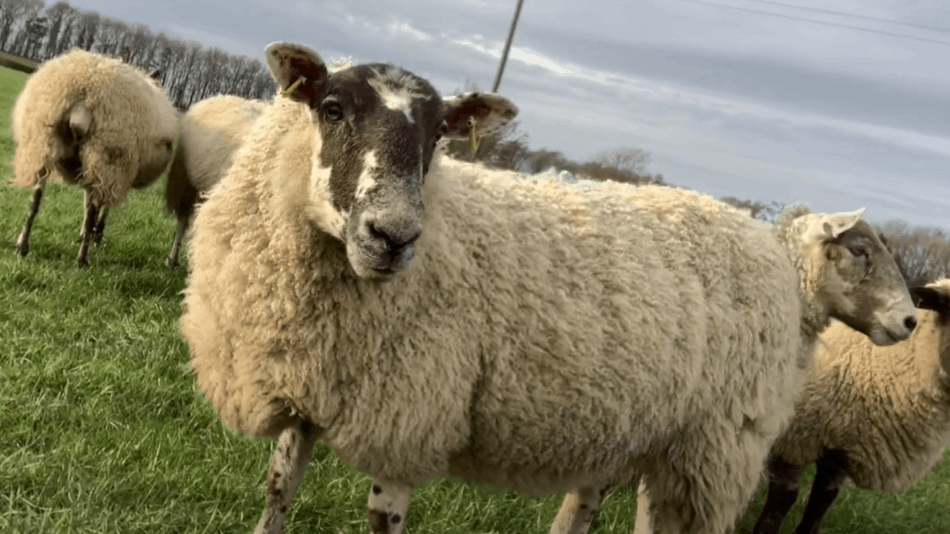

Lambs are perfect lawn mowers
- Backyard friendly
- Family friendly
- Grow while mowing your lawn
Ease: Fairly easy
Pros: Lambs are great grazers, quiet, family friendly, small pellets of manure that breakdown into your lawn fertilizer, need only water, fencing, shade and a salt block.
Cons: High heat or humidity is hard on lambs, hay (if needed) must be high quality, hard to see body condition under the wool.
Pounds of meat: For a lamb raised to 80 pounds, you will get 26 pounds of meat.
Lambs are wonderful meat animals to have and will grow while eating your lawn. They will need a fence of some sort, and, of course, water, shelter and a salt block.
Overall, lambs are easy, however, when they have problems lambs seem to be harder to rehab than other animals.
This requires you paying attention to them and fixing potential problems as soon as you see them starting. An easy way to avoid most of your lamb related problems is to buy high quality lambs to begin with.
Here is my article on How Many Bales Of Hay Do Sheep Need?, if you want or need to figure up a hay budget for your lambs.
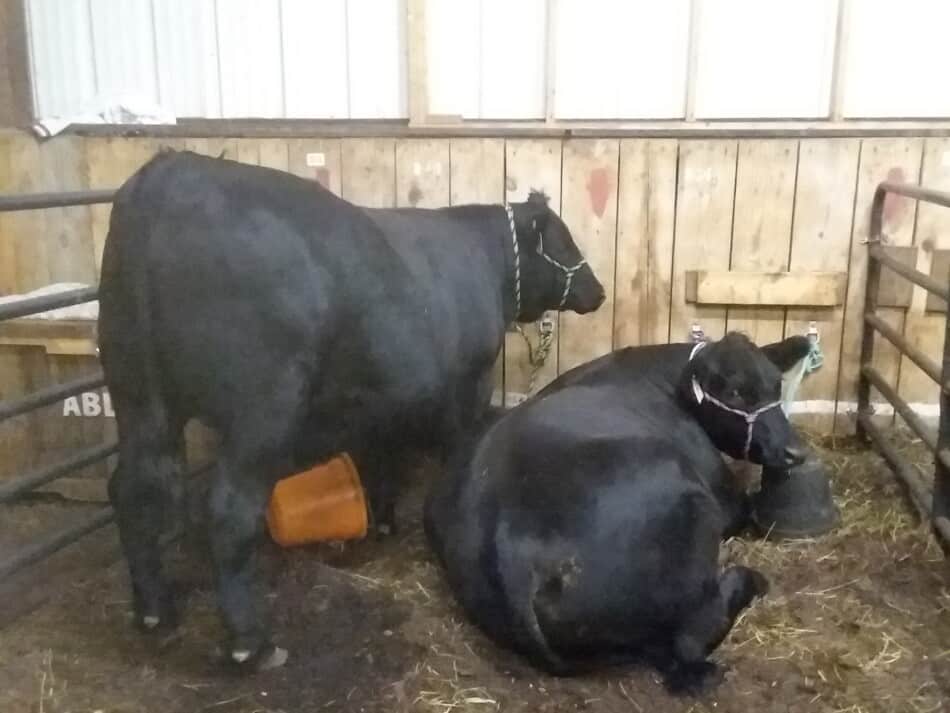
A steer is the most meat per animal
- The most meat per animal
- Great use of extra pasture
Ease: Challenging
Pros: Lots of meat per finished steer, great meat poundage return for the money spent, supplies are easy to find, wonderful use of extra pasture or unused grass areas (like right of ways)
Cons: Not backyard friendly, takes time to finish, need at least minimal handling facilities, will require hauling, more total money spent for steer, not commonly home butchered
Pounds of meat: You can figure 430 pounds of meat from a 1,000 pound finished beef breed steer. Dairy genetics will be lower yield, as will an unfinished beef animal.
I love cattle, but they do take a decent amount of acreage and can be challenging to handle, if you have no livestock experience. This is the reason why beef is listed as “challenging” in this section of meat options.
Cattle require some equipment, hauling, more cash outlay and more time than most other meat animals.
All of this is well worth the time and the cost for me and anyone else who has eaten home raised beef! But it may not be worth it to you, especially if you do not have the land available at low cost.
I have to admit, raising your own beef is a big milestone. I certainly love to see a freezer full of awesome (A.K.A. home raised beef), but feel obligated to caution the beginner. Starting with cattle will have a steep learning curve.
Unless you have a knowledgeable mentor, start with other meat animals and work your way up to cattle.
How much is a steer going to cost you? Read my article Is Raising Your Own Beef Worth It?
Turkeys are backyard friendly
- Most meat per bird
- Backyard friendly
Ease: Moderate
Pros: Easy to get poults, easy to find feed and supplies, quite a bit of meat per bird, backyard friendly, usually family friendly, broad breasted whites finish in 16 weeks, can be home butchered
Cons: Turkeys need the more expensive feed (not chicken feed), predators, finding a processor, can grow to crazy weights if you are not keeping track of the dates, heritage breeds take longer to grow and yield significantly less.
Pounds of meat: Per turkey you should get 31.5 pounds of meat from a 45 pound broad breasted white and 17.5 pounds of meat from a 25 pound heritage breed turkey.
Turkeys are a wonderful meat bird to raise! I am constantly surprised more people do not eat turkey throughout the year.
I enjoy the birds and love, love, love eating home raised turkey, but they can be a challenge. We hatch our own turkeys and raising them seems to go great or terrible.
This is the reason I listed turkeys as “moderate” instead of easy. They can occasionally be a disaster. Not all of the time, but sometimes.
Predators love them and the poults are not very hardy. For this reason, I would start with the broad breasted white and see how it goes.
If you want a different breed the next round, super. Try the BB whites for your first batch. They grow fast, are easy to find and will pluck beautifully.
Broad breasted whites will reach butchering weights in 4 months and females will weigh less than males. These birds are plump and pluck beautifully.
Heritage breeds will take 7 months and have more of a difference in weight between males and females. These birds are not as meaty and will be more challenging to pluck, because of the colored feathers.
10 Breeds Of Turkeys will give you my take on your heritage breed choices.
If you have some butchering experience, give home butchering turkeys a try. Turkeys are as easy as broilers, you just need a bigger scalding container.


Rabbits are backyard superstars
- Amazing meat production ability
- Family friendly
- Backyard superstar
Ease: Fairly easy
Pros: Backyard friendly, family friendly, easy to find feed and supplies, parents produce multiple litters per year, common through out the world, commonly home butchered
Cons: Not breeding in heat or cold, management is required from you, getting good meat type breeding stock, breeding stock is kept year round, finding a processor can be difficult
Pounds of meat: Per 5 pound live weight fryer (young meat rabbit) you should get 3.5 pounds of meat. This is for meat breeds with parents weighing 10 pounds or more, smaller breeds will have smaller fryers with less meat per fryer.
Rabbits are wonderful as a raise your own meat animal choice. To me, rabbits are the ultimate raise your own meat animal, since they are an option for nearly everyone.
Wondering how many rabbits you will need? Read my article Rabbits To Feed A Family Of Four.
The only reasons they are listed as “fairly easy” (rather than easy) is because they need some management and you need to butcher them yourself.
Since you keep the breeding stock and raise the fryers, you are responsible for breeding schedules, knowing kindling (birth) dates, selecting replacement stock and so on.
None of this is hard, but it is more involved than a meat animal that you just feed, like broilers, and buy more for the next batch.
The second catch with rabbits is you need to butcher them yourself. Unless you are fortunate enough to have a processor close by with open appointments, you will be the processor for your rabbits.
Here’s a tip for finding a processor (after looking online, of course): call the 4-H Extension office for your county. The county extension agent will know or can tell you how to find out.


Ducks are fast growing and hardy
- Backyard friendly
- Family friendly
- Hardy, fast growers
Ease: Fairly easy
Pros: Easy to find, fun to raise, hardier than chicks, backyard and family friendly, do not fly (so can’t go over your fence), will come to feed, finish in 8 weeks (Pekins), wonderful feed conversion rate (feed needed to get one pound of gain) of 2.3, adaptable to nearly any area, do not need to swim
Cons: Plucking, messy with water, some breeds are “talk” a lot, finding a processor, pin feathers (depending upon week of butchering), cost of butchering, finding a processor
Pounds of meat: For a Pekin duck, you should get 5 pounds of meat for a 7.5 pound live weight bird. Other breeds will grow slower.
Ducks are fun and wow can they grow fast! Pekin ducklings are ready to put in the freezer at 7-8 weeks! Ducks are fun to have around and a family friendly meat bird.
The down side of ducks is they are messy with water. It is amazing to me how a cute little duckling can guzzle water like that!
Looking for the math on raising your own ducks? Check out my article, Is Raising Ducks For Meat Worth It?
The main challenge for ducks as a meat animal, this is why they are “fairly easy” and not easy, is the plucking (for home processing) or finding a processor.
Aside from the plucking, I think ducks are easier meat birds to raise than broilers. Ducklings are hardier and more capable than the typical broiler chicks. Plus, ducklings have some personality, broilers, not so much.
Don’t let the processing aspect keep you from raising your own ducks. If you can butcher broilers, you can handle ducks. Make sure your scald is top notch and be ready handle more feathers.
Another plus to ducks as a meat bird is you can keep back some of the ducklings as breeding stock and raise your own ducklings from here on out. Additionally, ducks are wonderful layers, the Pekins will surprise you on this.

Geese are easy care grazers
- Easy care (once feathered out)
- Will graze the lawn
Ease: Fairly easy
Pros: Goslings are hardy, easy to raise, love to eat grass (when they are out of the brooder), don’t need a pond, you can find feed and supplies easily, common at most hatcheries and adult geese are hardy and can be kept back from your initial order to raise your own geese.
Cons: Goslings are more expensive than most other meat birds, take a long time to grow, need more space than smaller birds, eat more feed than smaller birds, processing can be an issue, predators like them.
Pounds of meat: You can expect to get 8.4 pounds of meat from a 12 pound and 12 week old goose.
Geese are a great option if you have some grass, like your lawn, that you want your meat birds eat for you. Geese can wander about your yard, but will still need a perimeter fence to keep them home.
If you love the taste of goose, definitely raise some for yourself. The cost of oven ready goose online is high, you can do better!
As with all waterfowl, plucking is the issue. You can home process geese, we do. If you plan on paying for processing, have your processing figured out before you order!
As far as breed goes, get the Embden to start. They are the main meat breed for geese and will be the most reliable performer. If you want a different breed for the next batch, go for it. Start with Embden to keep it simple.
If you are a total beginner to raising your own meat, I would start with broilers or ducks. They will be easier to learn on, faster and a bit less expensive of a project to start with.
Want more details on raising your own geese? Read my article Is Raising Geese Worth It?
Match your wants with what you can/will raise
All animals will excel in certain situations and have more difficulty in other situations. Your best results will come from matching the animals you raise to the resources you have.
You have a lawn: Lambs, rabbits, broilers and turkeys would be great in this situation.
If you have a few acres of out of control, shrubby overgrowth: think goats or pigs.
You have a small yard with picky neighbors: rabbits and broilers.
You drive by acres of unused right of ways or overgrown pastures: steers, lambs, goats or pigs.
Raise animals in multiple batches
A key way to handle raising your own meat is to spread out the growing animals, when possible, over two or three batches.
For example: if you need to raise 80 broilers, you can raise two batches of 40 or four batches of 20. Of course, you can do them all in one big batch, if you have the freezer space.
The beauty of raising your own meat is that you get to choose how you do things. Plan you meat raising activities to suit yourself and your family!
Start with small projects and work up
Hopefully this article helps you think of ways to get started or expand the amount of meat you raise for your family. Above all, do not be discouraged!
Decide on the first meat animal that you can raise this year and get started!
Once you start to see results, you’ll gain confidence. Not too mention, have some brag worthy meat!
Everyone starts small, figures out what works for them and repeats. Give yourself a shot, you’ll be surprised at what you can learn!
